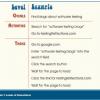user stories
 |
18 Questions to Ask for Better Backlog Refinement Refinement is time spent during the current sprint discussing and elaborating product backlog items so that they are ready for future sprints. Unfortunately, many teams do not unlock the full potential of refinement. Backlog items should be sliced, and a solution should be proposed, reviewed, and discussed. If your team is having trouble getting started, here are 18 questions you can use to trigger refinement discussions.
|
|
 |
Streamline Your Agile Requirements by Avoiding Bloated Backlogs In agile development, a bloated backlog results from teams accumulating huge lists of requirements, usually in the form of user stories. Retaining every possible story for building the product weighs down the backlog while squeezing (or obscuring) the highest-value stories. The best way to help minimize this risk is to optimize the time spent defining and refining the product priorities.
|
|
 |
Simplify Your User Stories: Make Them Independent Writing independent user stories seems simple, but it is actually difficult to do well. There are often parts of some stories that are dependent on other stories' functionalities, so it's not easy to keep them separated. Kris Hatcher relates how his team wrote and scored stories to keep them independent but still meeting acceptance criteria.
|
|
 |
Estimating Business Value in the Shark Tank You can use analytical methods to assign business value to a user story, of course, but another way is simple estimation. Allan Kelly describes an estimation exercise that combines the Scrum tool of planning poker with a TV show format to add some fun. You end up with enlightening conversation and revealed requirements.
|
|
 |
How Do You Write Good User Stories? Expert answers to frequently asked questions. In this issue, David Hussman explains how to write good user stories.
|
|
|
|
Telling Better User Stories While the idea of a user story is simple on the surface, there are challenges to working with them. User story mapping is a useful way to organize, decompose, and prioritize user stories.
|
|
 |
From Here to Acceptance Test-Driven Development Acceptance test-driven development (ATDD) means different things to different people based on their experiences—from "It's all about testing" to "It has nothing to do with testing,” and from "TDD, ATDD—it's all the same" to "TDD and ATDD are nothing alike." These nine landmarks will help you navigate ATDD no matter where you are coming from.
|
|
|
|
A Story About User Stories and Test-Driven Development: Into the Field Drawing on real events from the authors' combined experience, this story picks up where it left off in the November 2007 issue and follows a fictional team as it encounters some of the pitfalls of using test-driven development.
|
|
Visit Our Other Communities
AgileConnection is a TechWell community.
Through conferences, training, consulting, and online resources, TechWell helps you develop and deliver great software every day.

